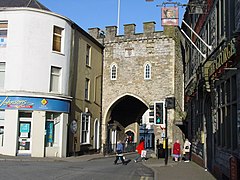Chepstow Town Gate
| Town Gate, Chepstow | |
|---|---|

The Town Gate from the west, with the George Hotel on the right
|
|
| General information | |
| Town or city | Chepstow |
| Country | Wales |
| Coordinates | 51°38′27″N 2°40′36″W / 51.640966°N 2.676558°WCoordinates: 51°38′27″N 2°40′36″W / 51.640966°N 2.676558°W |
| Completed | c.1278 Rebuilt 1524 |
| Renovated | 1985-86 |
| Designations | Grade I listed |
The Town Gate at Chepstow, Monmouthshire, Wales, was historically the only landward entrance to the town through the Port Wall, and a point where tolls for those resorting to the town and its market were collected. It was originally built, with the wall, in the late thirteenth century. The current archway mainly dates from the sixteenth century, but has been restored and partly rebuilt on several occasions. It is located at the western end of the town's High Street, and is a Grade I listed building.
After the Norman conquest of England and parts of south Wales, Chepstow developed as an important port and trading centre within the Marcher Lordship of Striguil. In 1270 the lordship came under the control of Roger Bigod, 5th Earl of Norfolk, after the death of his uncle. Bigod undertook a substantial building programme within and around Chepstow, including, at the Castle, a new range of buildings for accommodation for himself and his family, and a massive new defensive tower (now known as "Marten's Tower"); and also, a few miles to the north, the rebuilding of Tintern Abbey. He was also responsible for the building of the Port Wall, usually dated at 1274-78, and the Town Gate; and, in 1294, for granting to his close associate, John ap Adam of Sedbury, the right to hold a regular market at Chepstow. The Port Wall and Town Gate together ensured that only those paying tolls to the lord could attend the market; and had the additional purpose of keeping out undesirable elements, including the occasionally hostile Welsh people living in the countryside to the west of the town.
The Town Gate building is square in plan, with battlements on top, and originally could be blocked with a portcullis, no longer extant. It is hemmed in by buildings on all sides, including, to the east, the Gate House and, to the west, the George Hotel. On the western side of the Gate are two worn and illegible heraldic angels, probably dating from a rebuilding of the gate by Charles Somerset, 1st Earl of Worcester, in 1524. The Earl was responsible for granting a charter to the town, which was described at the time as "fallen into great ruin, indigence and decay", and allowed the town's bailiffs to use the room above the archway as a prison. The Gate was recorded as the "New Gate" in 1687, suggesting that an earlier gateway may have existed in the area.
...
Wikipedia
